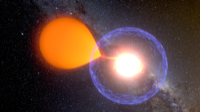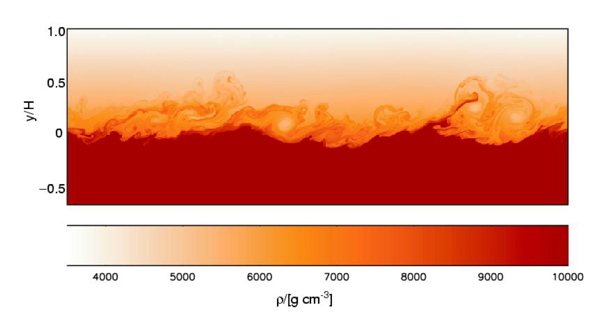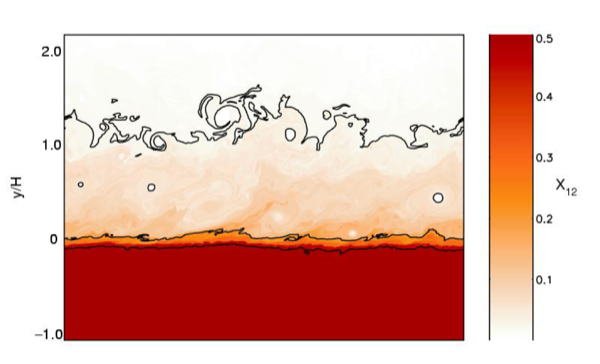
|
Cococubed.com
|
| Novae |
Home
Astronomy research
Software Infrastructure:
MESA
FLASH-X
STARLIB
MESA-Web
starkiller-astro
My instruments
Neutrino Emission:
Neutrinos from de-excitation
Neutrino emission from stars
Identifying the Pre-SN
Neutrino HR diagram
Pre-SN Beta Processes
Pre-SN neutrinos
White dwarf pulsations:
12C(α,γ) & overshooting
Probe of 12C(α,γ)16O
Impact of 22Ne
Impact of ν cooling
Variable white dwarfs
MC reaction rates
Micronovae
Novae
White dwarf supernova:
Stable nickel production
Remnant metallicities
Colliding white dwarfs
Merging white dwarfs
Ignition conditions
Metallicity effects
Central density effects
Detonation density
Tracer particle burning
Subsonic burning fronts
Supersonic fronts
W7 profiles
Massive stars:
Pop III with HST/JWST
Rotating progenitors
3D evolution to collapse
MC reaction rates
Pre-SN variations
Massive star supernova:
Yields of radionuclides
26Al & 60Fe
44Ti, 60Co & 56Ni
SN 1987A light curve
Constraints on Ni/Fe
An r-process
Effects of 12C +12C
Neutron Stars and Black Holes:
Black Hole spectrum
Mass Gap with LVK
Compact object IMF
He burn neutron stars
Stars:
Hypatia catalog
SAGB stars
Nugrid Yields I
He shell convection
BBFH at 40 years
γ-rays within 100 Mpc
Iron Pseudocarbynes
Pre-Solar Grains:
C-rich presolar grains
SiC Type U/C grains
Grains from massive stars
Placing the Sun
SiC Presolar grains
Chemical Evolution:
Radionuclides in 2020s
Zone models H to Zn
Mixing ejecta
Thermodynamics, Opacities & Networks
Radiative Opacity
Skye EOS
Helm EOS
Five EOSs
Equations of State
12C(α,γ)16O Rate
Proton-rich NSE
Reaction networks
Bayesian reaction rates
Verification Problems:
Validating an astro code
Su-Olson
Cog8
Mader
RMTV
Sedov
Noh
Software Instruments
AAS Journals
2025 AAS YouTube
2025 Listing of 500+ Author Videos
2025 AAS Peer Review Workshops
2025 ASU Energy in Everyday Life
2025 MESA Classroom
Other Stuff:
Bicycle Adventures
Illustrations
Presentations
Contact: F.X.Timmes
my one page vitae,
full vitae,
research statement, and
teaching statement.
Nova explosions occur on the white dwarf (WD) component of a cataclysmic variable binary stellar system which is accreting matter lost by its companion. When sufficient material has been accreted by the WD, a thermonuclear runaway (TNR) occurs and ejects material in what is observed as a classical nova (CN) explosion. In this article, we continue our studies of TNRs on 1.25 M$_{\odot}$ and 1.35 M$_{\odot}$ WDs (ONeMg composition) under conditions which produce mass ejection and a rapid increase in the emitted light, by examining the effects of changes in the nuclear reaction rates on both the observable features and the nucleosynthesis during the outburst. We have incorporated a modern nuclear reaction network into our 1D, fully implicit, hydrodynamic computer tool.
We find that the updates in the nuclear reaction rate libraries change the amount of ejected mass, peak luminosity, and the resulting nucleosynthesis. Because the evolutionary sequences on the 1.35 M$_{\odot}$ WD reach higher temperatures, the effects of library changes are more important for this mass. We discovered that the pep reaction ($p + e^- \rightarrow d + \nu$) was not included in our previous studies, or to the best of our knowledge those of other investigators. Although the energy production from this reaction is not important in the Sun, the densities in WD envelopes can exceed 104 g cm-3 and the presence of this reaction increases the energy generation during the time that the pp chain is operating. Since it is only the pp chain that is operating during most of the accretion phase prior to the final rise to the TNR, the effect of the increased energy generation is to reduce the evolution time to the peak of the TNR and, thereby, the accreted mass as compared to the evolutionary sequences done without this reaction included.
Surface Hydrogen Burning Modeling of Super Soft Xray Binaries: Are They Supernova Ia Progenitors? (2004)
Nova explosions occur on the white dwarf (WD) component of a Cataclysmic Variable stellar system which is accreting matter lost by a companion. A Type Ia supernova explosion is thought to result when a WD, in a similar binary configuration, grows in mass to the Chandrasekhar Limit. In this paper by Starrfield we present calculations of accretion of Solar matter, at a variety of mass accretion rates, onto hot (2.3×105 K), luminous (30 L$_{\odot}$), massive (1.25 M$_{\odot}$, 1.35 M$_{\odot}$) Carbon-Oxygen WDs. In contrast to our nova simulations where the WD has a low initial luminosity and a thermonuclear runaway (TNR) occurs and ejects material, these simulations do not eject material (or only a small fraction of the accreted material) and the WD grows in mass. A hydrogen TNR does not occur because hydrogen fuses to helium in the surface layers, and we call this process Surface Hydrogen Burning (SHB). As the helium layer grows in mass, it gradually fuses either to carbon and oxygen or to more massive nuclei depending on the WD mass and mass accretion rate. If such a WD were to explode in a SN Ia event, therefore, it would show neither hydrogen nor helium in its spectrum as is observed. Moreover, the luminosities and effective temperatures of our simulations agree with the observations of some of the Super Soft X-ray Binary Sources and, therefore, our results strengthen previous speculation that some of them (CAL 83 and CAL 87 for example) are probably progenitors of SN Ia explosions. Finally, we have achieved SHB for values of the mass accretion rate that almost span the observed values of the Cataclysmic Variables.

HR of accreting WDs and SSS |
On Heavy Element Enrichment in Classical Novae (2004)
Many classical nova ejecta are enriched in CNO and Ne. Rosner et al. (2001) suggested that the enrichment might originate in the resonant interaction between large-scale shear flows in the accreted H/He envelope and gravity waves at the interface between the envelope and the underlying C/O white dwarf. The shear flow amplifies the waves, which eventually form cusps and break. This wave breaking injects a spray of C/O into the superincumbent H/He.
Using two-dimensional simulations, in this article we formulate a quantitative expression for the amount of C/O per unit area that can be entrained, at saturation, into the H/He. The fraction of the envelope that is enriched depends on the horizontal distribution of shear velocity and the density contrast between the C/O white dwarf and the H/He layer but is roughly independent of the vertical shape of the shear profile. Using this parameterization for the mixed mass, we then perform several one-dimensional Lagrangian calculations of an accreting white dwarf envelope and consider two scenarios: that the wave breaking and mixing is driven by the convective flows; and that the mixing occurs prior to the onset of convection. In the absence of enrichment prior to ignition, the base of the convective zone, as calculated from mixing-length theory with the Ledoux instability criterion, does not reach the C/O interface. As a result, there is no additional mixing, and the runaway is slow. In contrast, the formation of a mixed layer during the accretion of H/He, prior to ignition, causes a more violent runaway. The envelope can be enriched by $\lesssim$ 25% of C/O by mass (consistent with that observed in some ejecta) for shear velocities, over the surface, with Mach numbers $\lesssim$ 0.4.

Breaking C/O waves |

12C mass fraction |
7Be and 22Na (1998)

7Be decay |

22Na upper limits |







